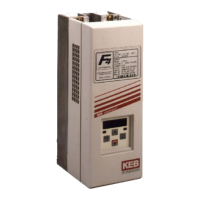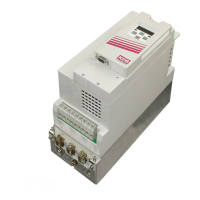
Do you have a question about the KEB COMBIVERT F3 and is the answer not in the manual?
| Series | COMBIVERT F3 |
|---|---|
| Category | Inverter |
| Protection Class | IP20 |
| Enclosure Rating | IP20 |
| Protection Features | Overcurrent, overvoltage, undervoltage, overtemperature, short circuit |
| Communication Interfaces | CANopen |
| Cooling Method | Fan-cooled |
| Humidity | < 95% relative humidity, non-condensing |
Notice capacitor discharge time before working on the unit.
Braking resistor must be installed fire-resistant and safe from touch.
Check for transport damage, warranty conditions, and short circuit proof.
Guidelines for installation personnel, regulations, cable handling, and voltage.
Compatibility and regulations for using FI switches with inverters.
Overview of PTC evaluation and motor protective switches/relays.
Guidelines for safe operation, switching, and speed search.
Measures for improving reliability using filters and proper wiring.
Measures to reduce interference pulses affecting electric plants.
Requirements for ambient conditions like temperature and humidity.
Guidelines for installing the inverter in a cabinet with required clearances.
Requirements for vertical installation, cooling, and managing nearby interference sources.
Diagrams and data for airflow and cabinet cut-outs for cooling.
Table detailing cabinet surface area required per inverter.
Graphs illustrating load capacity based on motor type and frequency.
Descriptions of power curves for different motor types and operating conditions.
Table of output capacity, current, voltage, frequency, and fuses.
Power reduction for altitude and safety for fuse replacement.
Table of output capacity, current, voltage, frequency, and fuses.
Power reduction for altitude and safety for fuse replacement.
Data for larger 400V models including output and electrical specifications.
Power reduction for altitude and safety for fuse replacement for larger models.
Diagrams and table for physical dimensions of 200V class inverters.
Diagrams and table for physical dimensions of 400V class inverters.
Instructions for proper earthing of the inverter and associated cables.
Schematic for power circuit connections for 200V class, sizes 13-14.
Schematic for power circuit connections for 200V class, sizes 15-18.
Schematic for power circuit connections for 400V class, sizes 07-14.
Schematic for power circuit connections for 400V class, sizes 15-16.
Diagram illustrating options for selecting input voltage.
Schematic for power circuit connections for 400V class, sizes 17-21.
Diagram illustrating options for selecting input voltage.
Diagram of operator layout and description of its functions.
Detailed explanation of the digital operator's capabilities and usage.
Diagram showing terminal assignments for the control board connections.
Comprehensive table detailing terminal functions, signals, and specifications.
Labeled diagram identifying each control on the digital operator.
Explanation of the status indicated by each LED on the operator.
Description of the operational purpose of each button on the operator.
Explanation of the functions performed by the change-over buttons.
Explanation of the 5-digit LED display and its readouts.
Operation, set-point adjustment, and status probe in Drive Mode.
Parameter adaptation for different application conditions.
Monitoring of frequency, current, and voltage at the output.
Display of faults for the purpose of evaluation.
Step-by-step guide for starting the inverter in Drive-Mode.
Operator status indicated by LED illumination in Drive-Mode.
Procedure to switch to Drive-Mode using the PRGM/DRIVE key.
Flowchart detailing the error display after initial power-on.
Flowchart for displaying and adjusting set-point values.
Flowchart for displaying the actual output frequency.
Flowchart for displaying the actual output current.
Flowchart for displaying error messages.
Explanation of initial error display and subsequent operation.
How to view and adjust set-point values using operator keys.
Explanation of the actual output frequency display.
Explanation of the actual output current display.
Explanation of error display after last switch-off.
Table of Un-Parameters with display, example, and unit.
Example diagram showing how Sn-15 to Sn-18 parameters control functions.
Table of An-Parameters for preset frequencies and their settings.
Explanation of how Sn-04 and Sn-19 affect An-Parameter settings.
Table of bn-Parameters with range and factory setting.
Description of acceleration/deceleration time parameters.
Graphs showing set-point value amplification based on voltage/current.
Graphs showing set-point bias voltage adjustment.
Explanation of automatic adaptation for output voltage changes.
Explanation of slip compensation for torque fluctuations.
How to activate and use the power-saving function.
Explanation of different monitor display modes.
Setting the output voltage for multi-function analog output.
Notes on analog output behavior in Program-Mode.
Procedure to enter Program-Mode using the PRGM key.
Flowchart for navigating through An, bn, Sn, Cn parameter groups.
Description of Sn-01 parameter: factory set, non-editable.
Description of 16 selectable U/f characteristics.
Setting write protection for An, bn, Sn, Cn parameters.
Selecting set-point value input method (operator or external).
Selecting stop methods like run-down, DC-braking.
Setting the behavior of the stop key on the operator.
Permitting or prohibiting reverse rotational direction.
Activating or deactivating the digital filter for control inputs.
Configuring analog output for frequency or current.
Setting S-curve characteristics for ACC/DEC.
Inverting set-point value behavior.
Defining behavior when set-point value is interrupted.
Configuration of overload detection and its response.
Parameter reserved for options.
Parameter reserved for 'No Function'.
Configuring stall function behavior and deceleration times.
Enabling electronic overheating protection for the braking resistor.
Defining fault relay operation during auto-reset/restart.
Configuring inverter response to power failures.
Configuring behavior of external fault signal input.
Enabling motor protection for standard motors.
Assignment of multi-function terminals.
Configuration of analog multi-function inputs and outputs.
Configuration of open-collector multi-function outputs.
Parameters related to optional modules.
Description of Sn-01 parameter: factory set, non-editable.
Description of 16 selectable U/f characteristics.
Guidance on when to use characteristics with increased boost.
Graphical representation of various U/f characteristics.
Configuration of parameter write protection.
Digit settings for parameter Sn-04 (stopping method, operator control).
How Sn-04 setting 00 controls deceleration via DEC ramp.
How Sn-04 setting 01 controls motor run-out.
How Sn-04 setting 10 controls DC-braking.
How Sn-04 setting 11 controls deceleration with time lock.
Behavior of the stop key on the operator.
Permitting or prohibiting reverse rotational direction.
Activating or deactivating the digital filter for control inputs.
Configuring analog output for frequency or current.
Setting S-curve characteristics for ACC/DEC.
Inverting set-point value behavior.
Defining behavior when set-point value is interrupted.
Configuration of overload registration and its response.
Parameter reserved for options.
Parameter reserved for 'No Function'.
Details on overload registration modes and their effects.
Parameter description for optional modules.
Parameter description for 'No Function'.
LA-Stop function for overcurrent protection during acceleration.
LD-Stop function for overvoltage protection during deceleration.
Stall-function protects against overload during constant speed.
Setting deceleration time for stall function.
Electronic overheating protection for braking resistor.
Response threshold depends on input voltage; potential issues listed.
Fault relay switching behavior during auto-reset/restart.
Inverter response to short-time power failures.
Configuring behavior of external fault signal input.
Constant or Run-Mode evaluation of external fault input.
Deceleration or continuation based on external faults.
Enabling motor protection for standard motors.
Selecting protection for self-cooling or fan-cooled motors.
Adjusting motor current (Cn-09) if non-standard motors are used.
Table of values for programming multi-function inputs.
Selecting forward/reverse operation via terminal 5.
Switching between preset values and operator input.
Switching between option preset and inverter preset.
Selecting multi-step speed settings.
Setting jog frequency via An-09.
Switching between ACC1/DEC1 and ACC2/DEC2.
Using terminal for external control inhibition.
Stopping ramps during signal duration.
Behavior on OH-Alarm display.
Activating the 2nd set-point value input via terminal 16.
Reserve parameter.
Configuring behavior for external fault inputs.
Activating DC-braking function.
Starting with maximum frequency for Speed-Search 1.
Starting with REF-frequency for Speed-Search 2.
Activating the power-saving function.
Using external control inhibition with speed search.
Conditions leading to OPE03 error code.
Operating inverter in 3-switch operation with FWD/REV selection.
Switching between preset values and operator input.
Switching between option preset and inverter preset.
Using inputs for multi-step speed and jog functions.
Choosing between ACC1/DEC1 and ACC2/DEC2.
How Sn-15 digit settings affect external fault input behavior.
Priority of faults in case of simultaneous faults.
Behavior of secondary faults.
Deceleration or continuation based on external faults.
Configuring multi-function analog input terminal 16.
Adjusting set-point values and their amplification.
Output signal indicating inverter run status.
Comparator for set-point value and actual frequency.
Output signal dependent on frequency.
Output signal closed during Run-phase.
Output signal closed when frequency is below fmin.
Output signal closed when actual frequency is within set-point range.
Output signal closed when actual frequency is within set-point range.
Output signal closed when actual frequency is outside set-point range.
Output signal closed when inverter is ready and no malfunction.
Output signal closed when undervoltage is detected.
Output signal closed during disconnection of power modules.
Output signal based on set-point value source.
Control signals based on operator or external input.
Output signal indicating detected overload.
Output signal for missing set-point value.
Output signal for braking resistor or transistor fault.
Output signal for faults that stop operation.
Setting the input voltage for the inverter.
Parameters for U/f characteristic selection and voltage calculation.
Setting the fade-out range for carrier frequency.
Selecting display modes for frequency and speed.
Adjustable frequencies for multi-function outputs.
Setting the range for switching frequencies.
Setting upper and lower carrier frequencies.
Amplification factor for carrier frequency.
Setting the threshold for overload registration.
Setting the time for overload tripping.
Setting the LA-Stop level for current limitation.
Limiting the LA-Stop level.
Setting the stall function level for overload protection.
Factory settings for standard motors.
Setting motor no-load current.
Setting delay for slip compensation.
Configuring automatic restart behavior.
Setting tripping time for power failure detection.
Setting current for Speed-Search activation.
Setting deceleration time for Speed-Search.
Setting minimum base-block time to deexcite motor.
Adjusting U/f characteristic proportionally for Speed-Search.
Setting time for voltage return to normal U/f characteristic.
Setting the upper limit for set-point value.
Setting the lower limit for set-point value.
Setting resonance frequencies for fade-out.
Setting the extent of the fade-out range.
Selecting display modes for frequency input/display.
Adjustable frequencies for multi-function outputs.
Setting the range for switching frequencies.
Setting upper and lower carrier frequencies.
Amplification factor for carrier frequency.
Setting the switching threshold for overload registration.
Determining the time period of overload tripping.
Setting the LA-Stop level for current limitation.
Limiting the LA-Stop level.
Setting the stall function level for overload protection.
Factory settings for standard motors.
Setting motor no-load current.
Setting delay for slip compensation.
Setting stall function level for overload protection.
Factory settings for standard motors.
Setting motor no-load current.
Setting delay for slip compensation.
Configuring automatic restart behavior.
Setting tripping time for power failure detection.
Setting current for Speed-Search activation.
Setting deceleration time for Speed-Search.
Setting minimum base-block time to deexcite motor.
Adjusting U/f characteristic proportionally for Speed-Search.
Setting time for voltage return to normal U/f characteristic.
Setting time before power failure is detected.
Setting current for Speed-Search activation.
Setting deceleration time for Speed-Search.
Setting minimum base-block time to deexcite motor.
Adjusting U/f characteristic proportionally for Speed-Search.
Setting time for voltage return to normal U/f characteristic.
Incorrect settings, poor connections, or vibration causing loose cables.
Check shielding, consider filters for errors during large consumer use.
Disconnect power and wait 15 minutes before working on the unit.
Table to systematically locate error sources.
Contact KEB with unit/motor data if troubleshooting fails.
Displays undervoltage in the control circuit.
Output current exceeds 200% of rated current.
Intermediate circuit voltage exceeds limits.
Fault of the power module.
Check input lines, voltage supply, and wiring.
Check ACC/DEC times, motor switching, short circuits, or large motors.
Check high input voltage or short DEC time.
Address repeated OC/OL2 faults and external interference.
Heat sink temperature rises above 90°C.
Motor protection relay trips or overload detected.
Fault detected in braking transistor.
Fault detected at corresponding input terminal.
Transmission error within control or components.
Replace fan, clean filter for overheating.
Check U/f characteristic and motor/inverter data for overload relation.
Check machine, increase overload value if necessary.
Check braking resistor value, duty cycle, or exchange.
Check wiring and input conditions for failure cause.
Check plugs, perform power-on-reset.
Error due to incorrect parameter programming.
FWD and REV commands given simultaneously.
External base-block signal causes power module disconnection.
Inverter output frequency reduced after reaching fmax.
Check and correct parameters based on value table.
Check activation and parameters Sn-15 to Sn-18.
Check and adjust specific Sn-15 to Sn-18 parameter values.
Check reference signal, adjust levels, or reduce load.
Various resistors available, select based on application.
Steps to determine desired braking time.
Use module if desired braking time is shorter than calculated minimum.
Calculate braking torque considering load torque.
Calculate peak power for the worst-case scenario.
Select resistor based on peak power and duty cycle (ED).
Resistors usable only for listed sizes; do not exceed cyclic duration factor.
Check if module achieves desired braking time.
Braking torque must not exceed 1.5x rated motor torque.
Formula for calculating braking time without a braking module.
Formula for calculating braking torque.
Formula for calculating peak braking power.
Formula for calculating braking time with a braking module.
Values of K based on motor power for calculations.
Formula for calculating ED when cycle time is 120s or less.
Formula for calculating ED when cycle time is over 120s.
Explanation of how the article number codes are structured.
Explanation of the part number coding system.
Table of article numbers, resistance, power, and compatibility for 200V class.
Table of article numbers, resistance, power, and compatibility for 400V class.
Note on short-time peak braking power and dimensioning.
Information on parallel connection of GTR units for larger sizes.
Diagrams and table for physical dimensions of 200V class braking resistors.
Diagrams and table for physical dimensions of 400V class braking resistors.
Table of article numbers, voltage class, and dimensions for GTR 7.
Dimensional drawing of the external GTR 7 unit.
Wiring diagram for external braking module connection.
Wiring diagram for braking resistor without overcurrent relay.
Wiring diagram for braking resistor with overcurrent relay.
Voltage adaptation is necessary prior to starting.
Filters mains voltage to protect against malfunctions from large consumers.
Use RC filter for small inductive consumers.
Schematic diagram of the KEB Mains Filter.
Reduces interference from frequency inverter per DIN standards.
Use shielded/twisted cables, good grounding, install in steel cabinet.
Schematic diagram of the KEB Radio Interference Voltage Filter.
Description of accessory options available for different applications.
Attempted repair by unauthorized personnel voids the guarantee.
All measurements require an analog multimeter.
Check rectifier for deviations; short circuit can damage module.
Check power modules for deviations; exchange if necessary.
Check fuses for continuity; replace if defective.
Check fuses for continuity; replace if defective.
Products undergo multiple quality inspections before delivery.
Return unit with invoice number, delivery date, and fault cause.
No responsibility accepted for failures due to misuse or storage.
Technical changes reserved; reproduction prohibited.











